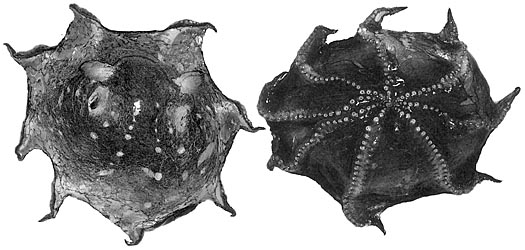Opisthoteuthis chathamensis
Steve O'Shea, Richard E. Young, and Michael VecchioneIntroduction
O. chathamensis is known from nine specimens most of which came from the Chatham Rise east of New Zealand.
Characteristics
- Arms and web
- Arms subequal.
- Arms I in males without increased robustness.
- Enlarged male suckers 10.6-11.9% of ML.
- Largest female suckers 4.7-7.0% of ML.
- Males with two fields of enlarged suckers present; largest sucker diameter of distal field about equal?? to that of proximal field; all arms with equal enlargement.
- Abrupt sucker enlargement on all arms and both fields in males.
- Male arms with first 3-4 suckers moderate in size, next 5-7 suckers abruptly enlarged, next 8-10 suckers (to web margin) of slightly reduced diameter, next 6-8 suckers abruptly enlarged, terminal 14-16 suckers rapidly decrease in diameter.
- Arm sucker counts in mature octopods 41-45 (males), 45-55 (females).
- Web nodules not described.
- Cirrus length 0.5-2 times maximum sucker diameter.
- First cirrus between suckers 2-4.
Comments
The above description is from O'Shea (1999). More details of the description of O. chathamensis can be found here.
O. chathamensis shares (where males are known) enlarged suckers in both proximal and distal fields that are the same on all arms with O. agassizii, O. bruuni, O. grimaldii and O. hardyi. It differs from from all of these species but O. bruuni in the low number of suckers on each arm (41-45 vs 58-80), it differs from O. bruuni in the number of suckers in the distal field (6-8 vs 2-3).
Distribution
The type locality is off eastern New Zealand near the Chatham Islands, 44°44'S, 77°15'W, 1180 m. The species is known only from this area and off the eastern coast of the north island of New Zealand (O'Shea, 1999). It is known from depths of 900-1438 m (O'Shea, 1999).
References
O’Shea, Steve. 1999. The Marine Fauna of New Zealand: Octopoda (Mollusca: Cephalopoda). NIWA Biodiversity Memoir 112: 280pp.
About This Page
Oceanic Sciences Research Institute
Auckland University of Technology
Private Bag 92006
Auckland, NZ
Richard E. Young
Dept of Oceanography
University of Hawaii
Honolulu, Hawaii 96822
USA
National Marine Fisheries Service
Systematics Laboratory
National Museum of Natural History
Washington, D. C. 20560
USA
Page copyright © 2003 , Richard E. Young, and
- First online 13 May 2003
Citing this page:
O'Shea, Steve, Young, Richard E., and Vecchione, Michael. 2003. Opisthoteuthis chathamensis . Version 13 May 2003 (under construction). http://tolweb.org/Opisthoteuthis_chathamensis/20156/2003.05.13 in The Tree of Life Web Project, http://tolweb.org/








